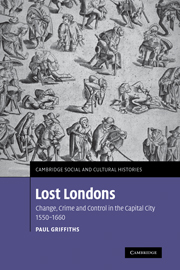Introduction: Rhetorics and records
Published online by Cambridge University Press: 15 December 2009
Summary
Lost Londons
‘The world is sare chaunged’, William Bullein wrote with wonder from London in 1564. ‘She is growne so great, I am almost afraide to meddle with her’, Donald Lupton wrote in 1632. London's size and shape changed speedily, and people felt that they were losing the city that they once knew. The population inside and outside the walls nearly quadrupled between 1500–1600, reaching roughly 200,000, and it almost doubled over the next five decades to around 375,000. The city spilled over its walls, numbers on the eastern edges soared more than fourfold in the seventeenth century (90,000), and sixfold in the West End in 1600–40 (18,500). Deaths outnumbered births and London would have shrunk without migrants. Our best estimate is that somewhere in the region of 5,600 were needed each year around 1650 to keep growth on track. Maybe one-in-six of the English spent time in London, hoping to strike it lucky.
My title – Lost Londons – expresses in a couple of words the sense of loss as ‘sare’ growth changed familiar environments and cultures for ever. Lupton ‘quartered’ London in the same year (1632) that aldermen looked to Whitehall for help when it became clear that the City freedom, once ‘of very great esteem is [now] grown to be of little worth’, cheapened by ‘the extraordinary enlargement of the suburbs’, ‘multitudes’ of new buildings ‘on every side’, and ‘great numbers’ of ‘foreigners’ from other counties and countries who settled outside the walls with the same ‘benefits’ as freemen, but without serving a single day as an apprentice.
- Type
- Chapter
- Information
- Lost LondonsChange, Crime, and Control in the Capital City, 1550–1660, pp. 1 - 24Publisher: Cambridge University PressPrint publication year: 2008



